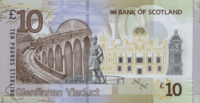Bank of Scotland £10 note facts for kids
| (United Kingdom) | |
|---|---|
| Value | £10 sterling |
| Width | 132 mm |
| Height | 69 mm |
| Security features | See-through window, raised print, security thread, mask, microlettering |
| Paper type | Polymer |
| Years of printing | 1695–present 2017–present (current design) |
| Obverse | |
 |
|
| Design | Walter Scott |
| Design date | 2017 |
| Reverse | |
 |
|
| Design | Glenfinnan Viaduct |
| Design date | 2017 |
The Bank of Scotland £10 note, often called a tenner, is a type of money used in the United Kingdom. It's a banknote worth ten pounds sterling. This note is the second smallest value made by the Bank of Scotland. The newest version, made of plastic, came out in 2017. It shows Sir Walter Scott on the front and the famous Glenfinnan Viaduct on the back.
Contents
History of the £10 Note
Paper money first appeared in Scotland when the Bank of Scotland was created in 1695. Early banknotes were very simple. They were printed in one color and only on one side.
Scottish banknotes are not officially "legal tender" everywhere in the UK. This means you can't always demand to pay with them. However, they are still legal currency. This means they are generally accepted as real money across the United Kingdom. Scottish banknotes are fully supported by the Bank of England. This gives them the same protection as Bank of England notes.
The £10 note is the second smallest banknote made by the Bank of Scotland. Unlike Bank of England notes, Scottish banknotes are not taken out of circulation in the same way. So, you might still see older versions of the £10 note. However, the Committee of Scottish Bankers asked people to use or swap old paper £10 notes before March 1, 2018.
Tercentenary Series (1995)
The Tercentenary series of notes was launched in 1995. This was to celebrate the bank's 300th birthday. Each note in this series features a picture of Walter Scott on the front. The £10 note has a diamond shape on the front. This helps people with poor eyesight tell it apart from other notes.
The back of the £10 note shows The Mound. This is where the bank's main office is located. The design on the back also highlights Scottish industries. For the £10 note, it shows the distilling and brewing industry. There are also three symbols on the back:
- Pallas: A goddess representing weaving, from the British Linen Bank.
- Saltire with gold bezants: Part of the Bank of Scotland's official coat of arms.
- Ship: A symbol from the Union Bank of Scotland.
Bridges Series (2007)
The Bridges series of banknotes came out in 2007. These notes replaced the older Tercentenary series. The size and color of the notes stayed the same. Walter Scott also remained on the front. The picture of The Mound moved to the front of the note. A new design featuring the Glenfinnan Viaduct appeared on the back. The writing on the notes was updated to look more modern. New, large, raised numbers were added to help people with poor eyesight.
Polymer Series (2017)
A new plastic £10 note was released on October 10, 2017. This new note is the same size as the plastic Bank of England £10 note. It still features Walter Scott on the front. The Mound is now shown on both sides of the note. On the back, it appears alongside the Glenfinnan Viaduct.
Designs of the £10 Note
| Note | First issued | Colour | Size | Design |
|---|---|---|---|---|
| Tercentenary | 1995 | Brown | 142 × 75 mm | Front: Walter Scott; Back: Distilling and brewing sector |
| Bridges | 17 September 2007 | Brown | 142 × 75 mm | Front: Walter Scott; Back: Glenfinnan Viaduct |
| Polymer | 10 October 2017 | Brown | 132 x 69 mm | Front: Walter Scott; Back: Glenfinnan Viaduct |

